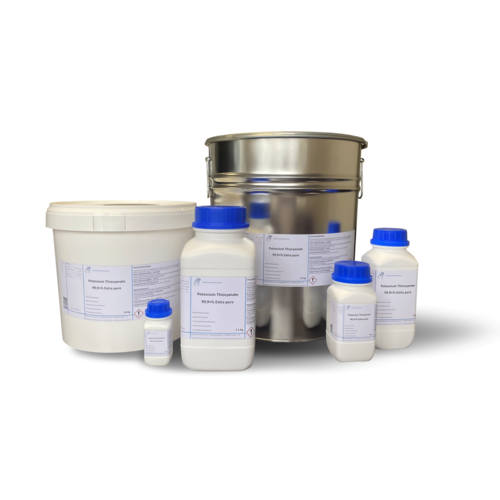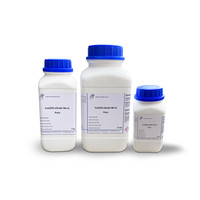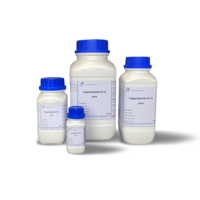You have no items in your shopping cart
Potassium thiocyanate 99.9 +% Extra pure
- Buy 2 and save 5%
- Buy 6 and save 10%
What is Potassium Thiocyanate?
Potassium thiocyanate (KSCN, also known as: potassium rhodanide) is a salt of thiocyanic acid (hydrothiocyanate acid).
At room temperature, potassium thiocyanate consists of crystals that slowly dissolve in air. It dissolves very well in water, which significantly cools the solution. The melting temperature is around 175 °C. The crystals are easily soluble in ethanol and acetone.
Potassium thiocyanate can be produced by fusing together potassium cyanide and sulfur or from potassium hydroxide and ammonium thiocyanate. The latter is obtained from carbon disulphide and ammonia under pressure and elevated temperature.
What is Potassium Thiocyanate used for?
Potassium thiocyanate serves as a sensing agent for Fe3+ ions present in aqueous solutions. The detection reaction is based on the formation of iron(III) thiocyanate, Fe(SCN)3, which is blood red in aqueous solution
Potassium thiocyanate can also serve as a detection reagent for copper(II) ions. For this, copper (II) ions are reduced with sodium sulfite solution to copper (I) ions, which form a colorless precipitate with thiocyanate:
Cobalt(II) ions can also be detected with potassium thiocyanate. This produces red-violet cobalt(II) thiocyanate in water, which turns blue when alcohol or acetone is added.
In addition, the chloride content of a nitric acid solution can be determined with a standard potassium thiocyanate solution by the Volhard method. This is a back titration. In the first step, the chloride ions are precipitated as silver chloride with a defined excess of silver nitrate. In the second step, the excess silver ions are then titrated against potassium thiocyanate. Fe3 + ions are used as an indicator:
Other applications include the production of cold mixes, pesticides, plastics and metal stains. It is also used in analog photography to show images.
Buy potassium thiocyanate?
You can buy the best quality potassium thiocyanate at Laboratoriumdiscounter. Delivered quickly and for a friendly price! Always with volume discount!
Technical data:
Empirical formula KSCN
Molar mass (M) 97.18 g/mol
Density (D) 1.89
Melting point (mp)175 °C
Solubility 2170 g/l (H2O, 20 °C)
WCK 1
CAS No.[333-20-0]
EC-No. 206-370-1
Downloads
$$$$$
Hazard statements
H302 + H312 + H332 Harmful if swallowed, in contact with skin and if inhaled.
H412 Harmful to aquatic life with long lasting effects.
Precautions - prevention
P261 Avoid breathing dust.
P280 Wear protective gloves / protective clothing / eye protection / face protection.
Precautions - response
P302 + P352 IF ON SKIN: Wash with plenty of soap and water.
Additional hazard information
EUH032 Contact with acids liberates very toxic gas.
%%%%%
| MSDS Kaliumthiocyanaat (NL) |
| MSDS Kaliumthiocyanat (DE) |
| MSDS Potassium thiocyanate (EN) |
| MSDS Thiocyanate de potassium (FR) |
| MSDS Tiocianato de potasio (ES) |









